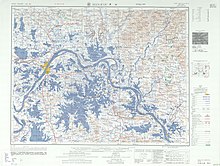Citations:Huang-kang
Jump to navigation
Jump to search
English citations of Huang-kang


- 1948, Hsien Chin Hu, edited by Ralph Linton, The Common Descent Group in China and its Functions[1], New York: The Viking Fund, page 71:
- The tsu of Chʻên in Huang-kang, Hupei, instituted school-land which was contributed by a number of members, each giving 5 mou.
- 1975, Michael Y. M. Kau, editor, The Lin Piao Affair[2], International Arts and Sciences Press, →ISBN, →LCCN, →OCLC, →OL, page 9:
- Comrade Hu Liang-yin, the principal of the school, was one of the earliest founders of the Party organization at the Huang-kang area, and he was an outstanding member of our Party.
- 2004, David Crystal, editor, The Penguin Encyclopedia[4], 2nd edition, →ISBN, →OCLC, page 901:
- Lin Biao or Lin Piao [lin byow] (1907-71) Chinese military leader, born in Huang-kang, EC China. He trained at Whampoa military academy in 1926, joined the Communists, and became a marshal of the Red Army.